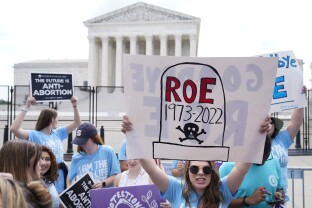Since Roe v. Wade was overturned, ballot initiatives have emerged as a key strategy for abortion rights advocates to prevent and override state abortion bans. But to those in the anti-abortion movement, the initiatives are nothing but a bump in the road to ultimately ending abortion in the U.S.
“The good news is that after this run, there are only a limited number of states that allow for state ballot initiatives to amend the state constitution,” Steven Aden, chief legal officer for the group Americans United for Life, said at the National Celebrate Life conference in Washington this summer.
“Once they go through this run, they won’t have any gas in the tank and they don’t know what to do next because they know it’s not going to change by and large at the state level and it’s also by and large a stalemate at the federal level,” he added.
Only 16 states allow citizens to collect a minimum amount of signatures to add a constitutional amendment proposal to the ballot. Abortion rights activists have pushed to use the measures to protect abortion access after a widely successful effort in Michigan in 2022.
This week, Arizona and Missouri — both of which have bans in place — became the latest to certify the signatures to add proposals brought by abortion rights advocates to their ballots, joining six other states where voters will decide on similar measures in November. Polls consistently show that a majority of Americans support abortion access and every abortion-related ballot initiative that has gone to voters since the Dobbs decision has gone in favor of protecting the procedure. (Donald Trump even predicted that the one in Florida, where he votes, will lean more “liberal” on the issue.)
But the opportunity for abortion rights supporters to add measures on ballots will run out. Most states either require their state lawmakers to create a ballot proposal — such as in California and Vermont, where their Democratic-led legislatures put measures on the ballot to protect abortion rights that were approved by voters in 2022 — or call for those collecting signatures to first present them to their legislature. In both cases, abortion rights advocates would face difficulties going through a Republican-majority legislature.
Abortion rights advocates say they’re already thinking ahead to how to use abortion messaging in campaigns to win over those state legislatures and other key races.
Sarah Standiford, national campaigns director for Planned Parenthood Action Fund, told NOTUS the organization has increased its voter-outreach efforts since the Dobbs decision, arguing that voters are “increasingly” more willing to switch their vote in favor of a candidate who supports abortion rights.
They’re focused on “tactics like deep canvassing, talking to people at the doors about their values and their personal stories that relate to somebody in their life who accessed abortion care, and translating those conversations into political engagement,” Standiford said.
“Where we have put this choice in front of voters, and we’re very clear about the stakes around reproductive freedom, voters have showed up for us, and that’s been true in these initiatives, but it’s been true in candidate elections as well,” said Jessica Mackler, president of EMILYs List, an organization focused on electing women who support abortion rights. She mentioned how campaigns with a heavy abortion focus succeeded in the 2022 Senate race in Nevada and in the 2023 elections for the Virginia state legislature and Kentucky governorship.
Abortion opponents, though, say Democrats really need the initiatives to fare well in elections. And they might have a point. A June poll from KFF of women voters showed they are more motivated to show up in November when there’s a measure on the ballot.
In Michigan, where abortion is constitutionally protected after the ballot measure was approved, 60% of women voters “say that the issue of whether abortion is legal in their state has already been settled” and were instead more focused on issues like inflation.
Some of the states where abortion will or is likely to be on the ballot — Nevada, Colorado, Maryland and New York — already protect abortion access through state law, so the initiatives are “only hyperbole and scare campaigns that [Democrats] try to push more as a ‘Get Out the Vote’ effort,” Kristi Hamrick, chief media strategist of Students for Life Action, told NOTUS.
Initiatives are “a one-and-done thing, which I find fascinating in regards to them; you can’t come back then in the next four years to change the constitution again,” Hamrick added.
Even with the silver lining, the anti-abortion movement is still fighting to stop the initiatives from being adopted.
In Arkansas, where abortion is banned, GOP state officials rejected the signatures for an initiative and argued its language was “misleading.” In Arizona, where the initiative will be on the ballot, Republican officials changed the language of the measure to adopt common anti-abortion phrases, switching “fetus” for “unborn human being.” A South Dakota anti-abortion group filed a lawsuit against an initiative in the state, arguing that Dakotans for Health, which is organizing the measure, did not follow the proper steps to submit its collected signatures.
The groups behind the initiatives say these are nothing more than last-ditch efforts to keep voters from deciding on the issue.
But the anti-abortion side is also looking to challenge the measures even if they are adopted. In Ohio, where voters supported an abortion rights initiative in 2023, a legal challenge is still ongoing on whether the state’s six-week ban can still be enforced, with Ohio Attorney General Dave Yost arguing that the case will go to the state’s Supreme Court. (For this reason, Standiford told NOTUS, abortion rights groups are focusing on state Supreme Court elections since they “interpret” the law.)
Anti-abortion advocates say it took 50 years of challenging abortion laws in court to slowly chip away at Roe v. Wade and, eventually, overturn it. What’s to say, they argue, that they can’t do it with these constitutional amendments.
“There’s a light at the end of the tunnel,” Hamrick said. “I don’t think a lot of people have broadly taken note of that.”
—
Oriana González is a reporter at NOTUS.
Sign in
Log into your free account with your email. Don’t have one?
Check your email for a one-time code.
We sent a 4-digit code to . Enter the pin to confirm your account.
New code will be available in 1:00
Let’s try this again.
We encountered an error with the passcode sent to . Please reenter your email.


